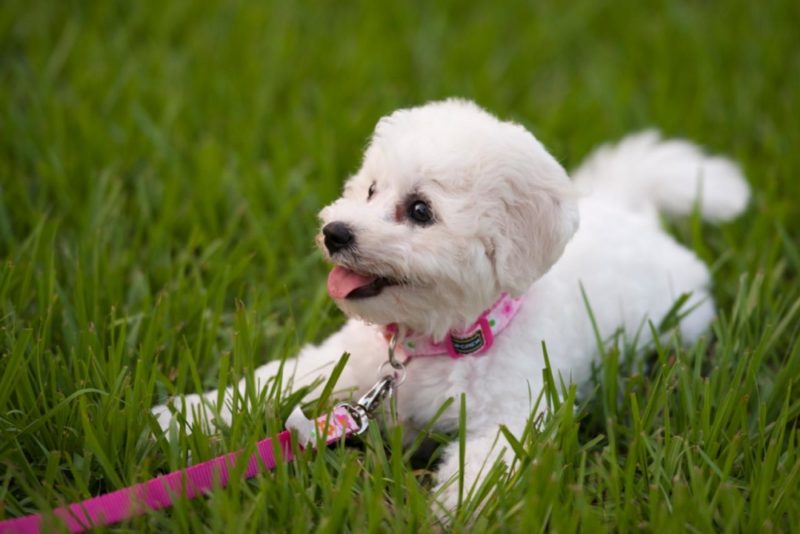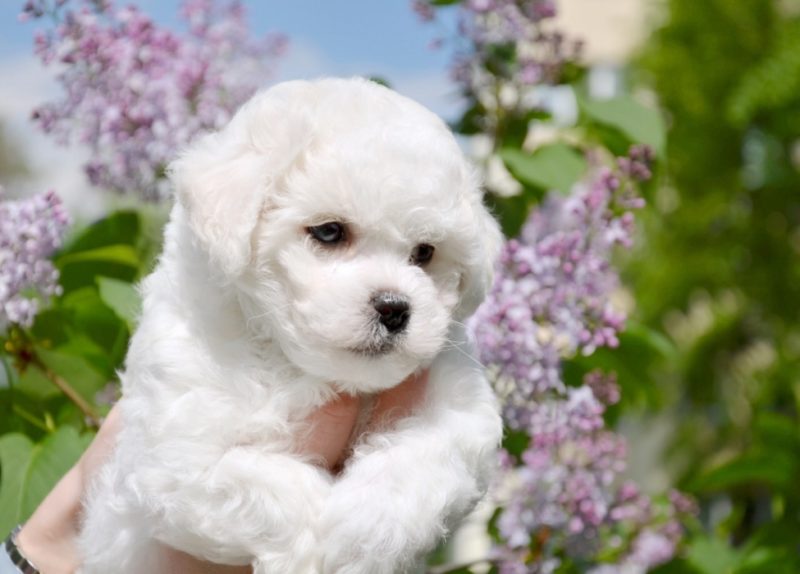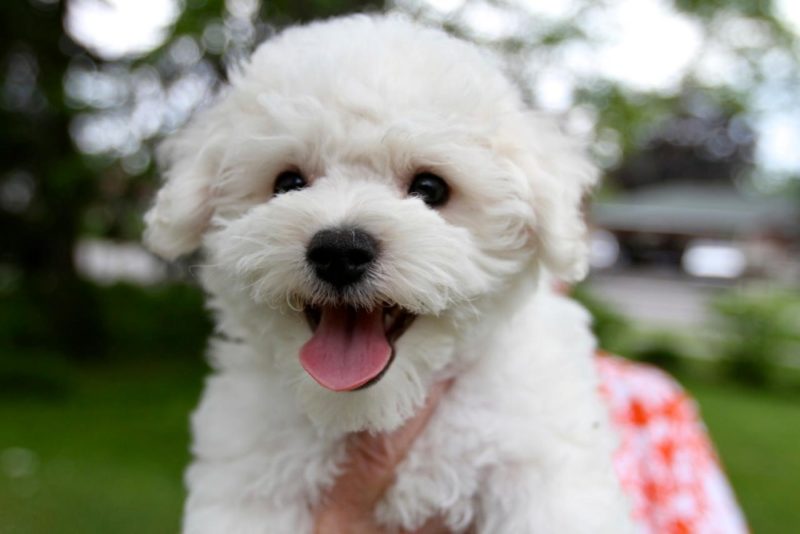Lap-dog is a common breed that includes several varieties. Often people, far from the world of dog breeding, confuse different types of these dogs with each other. What is special about a French lap-dog and how to care for it correctly?
Material Content:
Description of the breed of French lapdog
French lap-dog is a small white curly dog. These animals are also called "Bichon Frize", which literally means "curly-haired kitty." The toy, almost dwarf appearance of these doggies makes them the favorites of many people around the world.
For the first time, white wool of French lapdogs was mentioned at the end of the 13th century. The then dogs of this breed were used as rodent hunters. These creatures were especially popular with sailors who willingly took doggie aboard ships to exterminate rats. The compact size allowed the animals to feel great on board the swimming facility.
Bichons reached their peak of popularity in the 14th century. It was at this time that the lap-dogs began to be started as pets by aristocrats in Italy, and by the 16th century - in France.
It is interesting! Despite its name, the French lapdog was not bred in France. Like other varieties of lapdogs, the Bichon Frize came from small white doggies that lived in Tenerife in Spain. Later, these animals were crossed with other dog breeds. When in the 30s of the 20th century it was decided to register this breed, the dog handlers association dubbed the doggie Bichon Frize (from French bichon - “bearded”).A similar situation probably occurred due to conflicting information about the breed of animals. Be that as it may, it was the dog handlers of France who completed the development of the standard for this breed.
Residents of Russian-speaking countries often confuse representatives of different types of lapdogs. So, for example, Italian Bolognese and Bichon Frize in their understanding often appears under the general concept of a French lap-dog. But these animals belong to different branches of the breed.
Nature and behavior
Dog French lap-dog is a soft and friendly creature. These animals fit easily into family life. Doggies are well-trained, but can sometimes show waywardness and stubbornness.
These dogs are ideal for families with children and single elderly people. The lap-dog perceives even the child’s importunity with constant good nature and patience, never allowing himself to bite a small master and make him cry.
Boloniki impress with their ability to recognize the mood of the owner. If a person is saddened by something, the dog will give him maximum removal, trying to cheer and cheer him in every possible way. If the owner is busy, the miniature animal will not distract him and will go about his business in another part of the room, patiently waiting for the owner to free himself.
Attachment to humans is a virtue and, at the same time, a disadvantage of a lap-dog. If the owner does not pay due attention to her, the dog can become sick and sometimes fall ill.
Breed standard and puppy selection
Lapwings - dogs of neat size, not exceeding 30 cm at the withers and weighing 5-6 kg.
The body of the lapwort is small, with a strong chest, round ribs, a flat back and short limbs. The boiled-white coat is soft, highly curly, with a dense undercoat. Any discrepancy with the specified shade is a marriage. And although light opal in the ear area is acceptable, such individuals are not allowed to the exhibition.
The nose of small white doggies is exclusively black, the transition from the muzzle to the forehead is not very pronounced. In the big round eyes of a dark shade, proteins are practically not traced. Equally dark is the outline of the dog's eyelids. The lap-dog has the correct bite.
All of the listed features of the standard should be considered when choosing a Bichon Frize puppy. It is worthwhile to carefully examine the baby, noting its anatomical structure, especially the bite, the location of the limbs, etc.
Advice! Choosing a puppy, you should not rush to the most furry. Volumes of the coat does not always guarantee the correct structure of the hairs. The main indicator is the growth rate of the wool and its silky structure.
Given all the subtleties, it is recommended that you consult a specialist before buying a French lap-dog.
Maintenance, care and feeding
The French lap-dog is rather unpretentious to the conditions of detention. Cleanliness, lack of smell, and also a slight tendency to hair loss make this animal a welcome pet both in a private house and in an apartment. In addition, these miniature dogs are well accustomed to the tray. However, the owner should not be deceived: the fact that the animal can do its delicate things in a specially designated place does not mean at all that the dog does not need to walk. Walking for lapdogs is absolutely necessary.
After each boardwalk, the animal should wipe its paws. The pet’s ears and teeth also need periodic brushing. Claws should be cut off from time to time with the help of special nippers.
But the main concern of the owner is, of course, the hair of a snow-white pet. To make her look healthy and beautiful, she should be systematically combed and washed. And although the French lapdogs are curly-haired dogs, their hair is not tangled slightly, and therefore comb them three times a week. As a rule, this procedure does not cause any difficulties.
The corners of the eyes of the lapdogs should be wiped daily, since the organs of vision can watery due to the hair that gets into them. In this case, you can use a regular towel moistened with water, but in no case a cosmetic wet towel!
Note! If the owner expects that his miniature lapdog will become the winner of competitions and exhibitions in the future, he should worry about cutting the pet. According to French standards, shearing wool of Bichon Franche is unacceptable, it is only possible to trim the hair on the face and paws. However, in Russia and some other European countries, a decorative pet grooming is allowed. In this case, the procedure should be performed so that the dog’s head has the shape of a ball or a bell. The body is cut short, and a peculiar mane remains on the neck. If the owner is not ready to do the haircut yourself, it is better to take the pet to a professional groomer.
Since the coat of lapdogs is snow-white, and the pollution immediately becomes noticeable, so you should bathe the dog regularly.
As for the pet's diet, several recommendations should be considered:
- Lapworms grow quite quickly and are already considered as mature individuals at the age of 9 months. Given such a fast growth rate, the nutrition of these animals should be appropriate. At the same time, supporters of the natural menu should know that dishes intended for an adult pet and a puppy should not be the same. So, for example, it is better for younger dogs to give lean raw meat, after grinding it into small pieces.
- An animal eating natural food should additionally receive mineral supplements containing chitin, calcium and other necessary elements. Ready food, as a rule, already contains all the components necessary for the animal’s body.
- Lonely dogs should not be overfed, otherwise their skeletal system may become thinner, leading to arthritis and fractures. Nutritional standards for a particular dog are best determined with a veterinarian.
A lap-dog more than other dogs requires a correct diet. The abuse of goodies from the host table is fraught with possible manifestations of allergies.
Parenting and training
French lapdogs are animals that lend themselves well to training, and therefore training, as a rule, takes place in a lightweight form. And although some owners are sure that the decorative breeds of dogs do not need training, this opinion is erroneous. Any dog should be brought up and be distinguished by unquestioning obedience, especially when it comes to exhibition animals.
Bolonki love to bring positive emotions to the owners, and therefore carefully follow the owner's commands. Their flexible nature does not cause difficulties in the process of training. Completed assignment is best supported by praise and refreshments. If necessary, it is permissible to talk with a lap-dog strictly, but without a cry: these dogs are very sensitive to elevated tones.
Pros and cons of the Bichon Frize breed
The main advantages of acquiring a dog breed French lap-dog include:
- cheerful and good-natured disposition;
- non-conflict and coping - doggie is in excellent contact with other pets;
- Bichon Frize eat a little and do not bark without good reason.
However, the breed also has disadvantages, among which:
- The need for regular grooming of the coat.
- Emotional lapdogs - animals are very sensitive and can be upset at the slightest occasion.
- Sensitivity of the digestive system, a tendency to allergic reactions. For this reason, it is not recommended to feed the dogs from the owner's table.
French lap-dog is a charming snow-white dog. Animals of this breed are distinguished by a gentle, meek disposition and a strong attachment to the owner. The owner should remember the sensitivity of the dogs and be as tolerant and affectionate as possible to the pet.

















